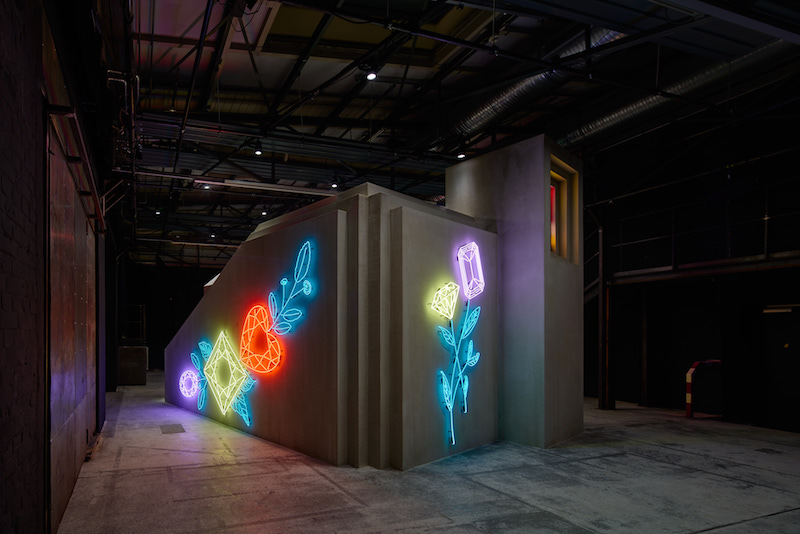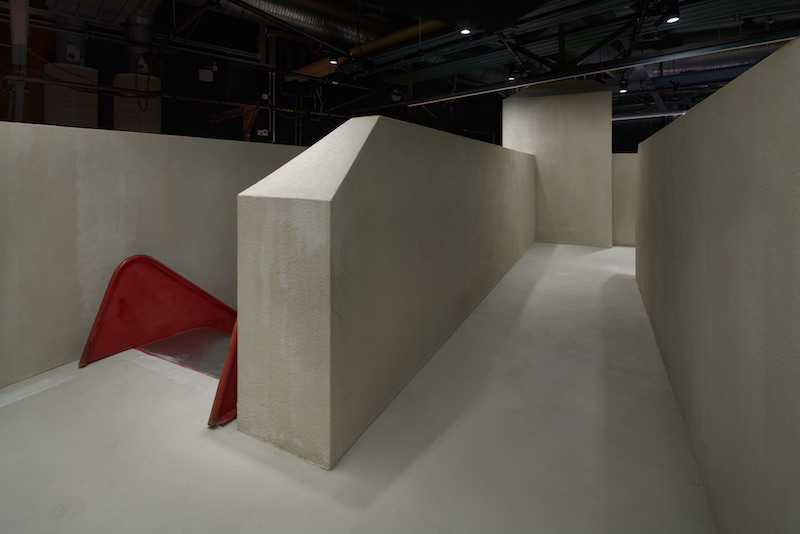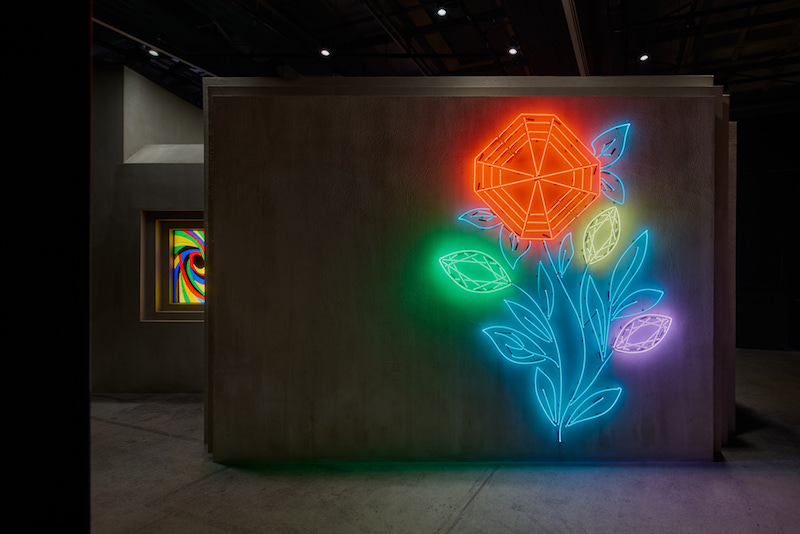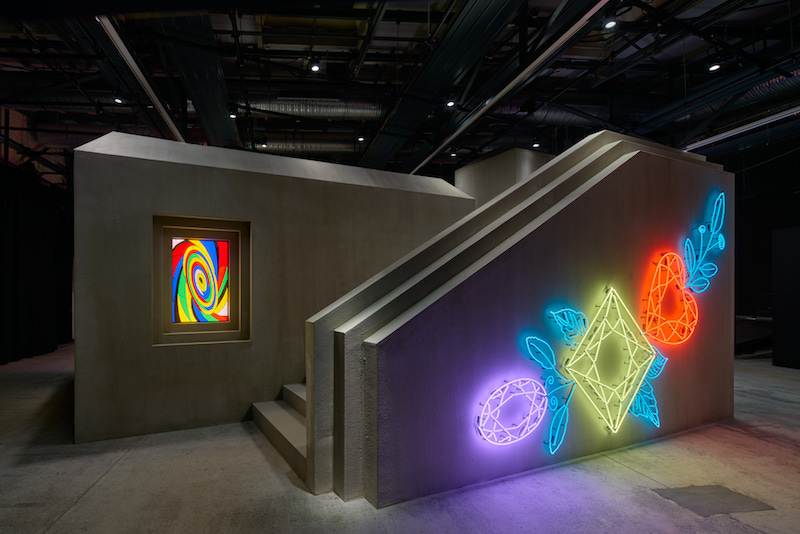by Johanna Hardt // Sept. 24, 2024
Going to an exhibition the morning after its opening night always feels like having missed the main event. But there is a melancholic beauty to it, too. A night just out of reach—the faint smell of smoke lingers, DJ set times still pinned to the wall next to the empty bar. The absence of people is palpable. A muted jingle meets me halfway down the stairs into TRAUMA’s central theatre space. Visitors are sparse this morning. They arrive reluctantly, testing the boundaries of the installation, uncertain whether to engage with it or observe it from a distance. They begin to move around the brutalist structure–its steep, angular geometry dimly lit, a solid mass of concrete imposing its presence. Stained-glass windows carve openings into the unyielding, raw surface of the structure, infusing it with soft hues to counterbalance its starkness. Neon lights in the shape of flowers and diamonds crawl up its sides, decorating its monumental expression. Together with the light melody, they counterpoint the weight of the architecture.

Esben Weile Kjaer: ‘Milky Way,’ 2024, installation view at Trauma Bar und Kino // Photo by Joe Clark
The sonic accompaniment to Esben Weile Kjær’s solo show ‘Milky Way,’ curated by Madalina Stanescu, is surprisingly subdued, given that it was created by Europa (Moritz Haas), whose aggressive yet melodramatic rave beats typically force one into submission. Instead of ruthless commands slamming into the body, the soundscape is of a quieter, more insidious variety. The steady, unhurried pace is, in its own way, propulsive. It takes on the rhythm of a leisurely yet inquisitive walk, effortlessly matching the cadence of footsteps as if to guide the visitor around the structure, up its steps and down its slide. As the melody progresses, its uplifting tones instil a growing anticipation of discovering something magical. A series of chimes reinforces this effect, suggesting the casting of a spell. Gradually, the track evolves, introducing elements that hint at something just over the horizon. Yet, this feeling remains suspended in a loop, echoing the visitor’s ceaseless orbit around the display, never quite breaking free but instead tracing an infinite path of anticipatory promise. This characteristic is the show’s guiding, mood-setting principle.

Esben Weile Kjaer: ‘Milky Way,’ 2024, installation view at Trauma Bar und Kino // Photo by Joe Clark
The structure’s distinctive triple-layered stepped walls evoke a design commonly used for reinforcement in military fortifications worldwide. On the other hand, its steep metal slide, cold steel framework and hard-edged brutalist aesthetic evoke Soviet playgrounds as symbols of state power and communal play. As the curatorial text explains, abandoned bunkers along the Danish coast became the artist’s accidental playground as a child. These bunkers form part of the Nazi Atlantic Wall, a chain of fortifications built through slave labour between 1939-41 along the coast of north-western Europe. With their origins in a grim chapter of history, bunkers reflect a temporal dissonance. Their decay materialises the passage of time, while their enduring presence invites repurposing. It is the schizophrenic tension in which these structures exist that seems to fascinate the artist most: how environments shaped by political ideologies and military function try to be reimagined.

Esben Weile Kjaer: ‘Milky Way,’ 2024, installation view at Trauma Bar und Kino // Photo by Joe Clark
While the bunkers of the Atlantic Wall might be decorated with overgrown grass or graffiti, Kjær’s installation features neon tubes shaped like diamonds sprouting from flowers. The deliberate choice of such an incongruous and alien element underlines the artist’s intention with the medium. Neon signs are attention-grabbing precisely because they stand out so starkly from their surroundings. Their use here opens up a range of interpretations, inviting dialogue on beauty and commerce, nature and artifice, high art and low culture, or marketing strategies and the commodification of nightlife spaces. These neon forms also resonate with the visual language of contemporary cinema, evoking nostalgia and retro-futurism, particularly associated with the aesthetics of the 1980s, when neon became an iconic visual marker in genres such as sci-fi and noir.

Esben Weile Kjaer: ‘Milky Way,’ 2024, installation view at Trauma Bar und Kino // Photo by Joe Clark
Kjær’s stained glass windows are another link to the history of branding. In the Middle Ages, they conveyed religious stories to the illiterate while serving as symbols of wealth to the patrons who commissioned them. As in contemporary advertising, light and colour were used to captivate viewers and communicate identity and values. In Kjær’s earlier stained glass works, historical imagery played a central role; later, they became self-referential, incorporating photographs of his performances. In this case, the windows are inspired by NASA images of the Milky Way, one of the most captivating objects in the night sky. This show is a precursor to ‘Solar System,’ Kjær’s large-scale solo exhibition at Kunsten Museum of Art in Aalborg, Denmark, opening in October. Here, the Milky Way is associated with themes of exploration, infinity or escape that resonate with the social and sensory experiences sought in nightclubs, where the body is free to enact out-of-control carnivalesque constructions deemed untenable by the norms of everyday life. Yet Kjær’s stagings run counter to the resilient narrative of dance clubs as otherworldly environments that promise a utopian fantasy of freedom, disconnected from material reality, historical constraints and the commercialisation and risk-aversion that define contemporary social spaces.
Exhibition Info
Trauma Bar und Kino
Esben Weile Kjær: ‘Milky Way’
Exhibition: Sept. 14–Oct. 12, 2024
traumabarundkino.de
Heidestraße 50, 10557 Berlin, click here for map
Kunsten
Esben Weile Kjaer: ‘Solar System’
Exhibition: Oct. 10, 2024–Mar. 16, 2025
kunsten.dk
Kong Christians Alle 50, 9000 Aalborg, Denmark, click here for map



















